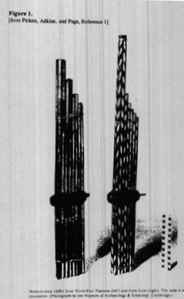
The khaen is constructed with free reeds mounted in bamboo pipe walls inside a carved wooden windchest. Each reed of the khaen sounds for both directions of air flow (inhaling and exhaling). The reed vibration is strongly coupled to the pipe resonance, and the reed will sound only if a small hole near the reed is closed, causing the resonant frequency of the pipe to be near that of the reed. For some examples of khaen made in northeastern Thailand, variations in frequency and sound spectrum with blowing pressure have been studied, with both positive and negative blowing pressures considered. The relationship between frequency of reed vibration and pipe length has been studied to determine the range of pipe length over which the reed can be made to sound, as well as the amount of frequency shift associated with changes in resonance frequency of the pipe. A comparison is made with a previously reported result that the sounding frequency of the reed-pipe combination is higher than the natural resonance frequencies of either the reed or the pipe taken alone. [L. E. R. Picken, C. J. Adkins, and T. F. Page, Musica Asiatica 4, 117--154 (1984).]
General Background
The khaen (also spelled kaen, khene, caen) is a free reed mouth organ indigenous to northeastern Thailand and Laos and is perhaps the most important musical instrument of the Lao people of this region. Since readers of this paper may be unfamiliar with the instrument, a brief description follows. More extensive general information on the instrument can be found in References 1-6.
The khaen employs metal free reeds, generally similar to organ or harmonica reeds, mounted in bamboo resonating pipes. The khaen is closely related in principle of operation to the two better known Asian free reed instruments, the Chinese sheng and Japanese sho. Unlike the free reeds found in Western instruments such as reed organ, accordion, and harmonica, the reeds of the khaen are approximately symmetric, so that the same reed operates on both vacuum and pressure (inhaling and exhaling). Examples of khaen are shown in Figure 1.
The free reeds used in the khaen are chiseled from a single piece of thin metal, typically a bronze alloy, and set into the bamboo pipe. For khaen made in northeastern Thailand the metal traditionally used is the "copper" coinage of Chulalongkorn Rama V, minted around 1900.[1] Figure 2 shows a diagram of typical khaen reeds and a closeup photo of a partially disassembled khaen, showing the mounting of the reeds.
In the khaen the frequency of reed vibration (pitch) is determined by both the reed and the pipe. One or, more commonly, two slots are cut into the back of the pipe, determining the effective acoustical length of the pipe so that the lowest resonant frequency of the pipe approximately matches the reed frequency, as shown in Figure 3.
As will be seen below, the vibrating frequency of the blown reed can, within certain limits, be pulled to match the pipe resonance, so that fine tuning is done by means of the position of the tuning slots. A finger hole is drilled at a point that destroys the pipe resonance and prevents the reed from sounding unless the hole is closed. Wind is provided by blowing either in or out through the mouthpiece which forms the opening of the air chamber that surrounds the reeds. Air flows through all the pipes continuously, whether the reed is sounding or not. The instrument is held upright with the air chamber supported by the hands. Fingers and thumbs of both hands are available to close the holes and sound notes. It is typical in playing the instrument that several notes are sounded simultaneously, some of them serving as drones.[2-4]
Introduction
Five khaen, all made in northeastern Thailand were obtained for use in the laboratory, and the series of measurements outlined below were made. Measurements on the relationships between frequency and blowing pressure and changes in the sound spectrum with pressure were done for positive as well as negative blowing pressure. Although each pipe has vent holes which determine the effective acoustical length of the tube, and hence the resonant tube frequency, the end sections beyond the vent holes do have acoustical significance. How the end sections of the tube affect the sound spectrum was studied, and tubes with and without these end sections were compared. The effects of altering the pipe length were a main focus of the investigation. Changes in frequency and spectrum were studied, as well as the extent to which the pipe length could be altered while still permitting the pipe to sound. Most measurements were done at normal playing pressure (0.6-0.8 kPa), but some effects were obtainable only at lower or higher than normal pressures.
Experimental Setup
The experimental setup is illustrated in Figure 4.
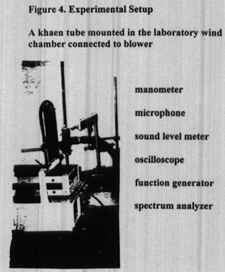
Mounted 10 cm away from the reed were a digital sound level meter and a microphone. The microphone was connected through a power supply into the vertical input of an oscilloscope for frequency measurements and also into an FFT spectrum analyzer for recording spectra of the radiated sound. A 15-megahertz synthesized function generator was connected to the horizontal input of the oscilloscope, making it possible to measure the frequency of the reed and tube within 0.01 Hz using Lissajous figures.
Procedure
Measurements were performed on pipes from three different khaen. These pipes covered most of the frequency range of the khaen, ranging from slightly under 200 Hz to over 600 Hz. Pressure measurements were usually begun near the lowest blowing pressure for which the pipe could be made to sound, then increased by 0.1 kPa increments to 1.0 kPa. There were two methods of altering the pipe length. The first involved making the tube longer by covering the vent holes, then adding pieces of other similar tubes to one or both ends to keep the reed position at one-fourth of the tube length. To make the tube shorter, the tube was cut, again proportionately so that the reed position was kept at one-fourth of the tube length.
Variation in frequency with blowing pressure
Figure 5 shows typical graphs of frequency vs. blowing pressure. These graphs show a general trend of decreasing frequency with increasing blowing pressure, a trend that has been observed for other free reed instruments.[7, 8, 9] Measurements were made for both positive and negative pressure.
Although both directions of air flow show the same general trend, the pipes tested did not sound as easily at low positive blowing pressure. For positive pressure, 0.1-0.3 kPa more pressure is often needed to initially sound the pipe. The higher pitched pipes seemed to show this difference more than the lower pitched ones. At normal playing pressure for the higher pitched pipes, the frequencies were very close for positive and negative pressure. At less than normal playing pressure, the difference between positive and negative playing pressure was sometimes as great as 2 Hz.
Variation in sound spectrum with pressure direction
Figures 6 and 7 illustrate the differences in spectra between positive and negative playing pressure. For negative normal playing pressure in a treble tube (Figure 6), the spectrum shows a large third harmonic, smaller first and second harmonics, and a small fourth harmonic. In the positive pressure spectrum the amplitudes of the harmonics above the third are substantially less than those for negative pressure and the sound level is typically 3-5 dB less than for negative pressure. For the positive pressure example shown in Figure 6, the spectrum shows a large second harmonic, smaller first and third harmonics, and an even smaller fourth harmonic. This closely matches the spectrum expected because of the position of the reed. As shown in Figure 3, the reeds are placed one fourth of the acoustical length from the bottom vent hole, making that distance one-eighth of the wavelength. This would be at the position of a pressure antinode for the second harmonic, and a pressure node for the fourth harmonic.
For the bass tube (Figure 7), the spectra are somewhat similar to those for the treble tube, although there are small differences. For negative pressure the second and third harmonics are the largest, with the fourth being smaller and the first harmonic much smaller. The positive pressure graph again shows a large second harmonic, with the fourth harmonic being relatively small. As with the treble tube, the negative pressure has higher sound level, about 4 dB higher.
Variation in tube frequency with and without end sections
The end sections of the tubes have little effect on the pipe frequency because the vent holes determine the effective acoustical length of the tubes. These end sections do, however, affect the sound. By comparing the same tube with and without the end sections, as seen in Figure 8, we found the frequency, sound level, and spectrum to all be different. The overall loudness was much higher in the tube with no end sections. At the tested pressure, the sound level was about 6 dB higher. The frequency had only about a two percent difference. The spectra of the two tubes were very similar for the first three harmonics. It can be seen that the spectra are much different for the higher harmonics.
Variation in frequency with tube length
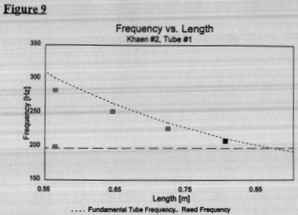
Figure 10 shows the result of increasing the original acoustical length, by initially adding tubing.
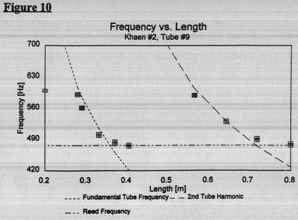
It should be noted that our experience with the khaen pipes as they came from the instrument has been that the pipes are constructed in such a way that the natural frequency of the reed, the fundamental resonance frequency of the pipe, and the normal playing frequency closely coincide. The results presented in Figures 9-12, however, show that it is possible to construct a pipe in which the sounding frequency of the reed-pipe combination is higher than the natural resonance frequencies of either the reed or the pipe taken alone, as reported in Reference 1.
Ability of the reed to sound determined by tube length
The reed could not be made to sound at certain lengths of the elongated tube. Figure 10 shows a region in which the reed did not sound, where the reed frequency is not near either the fundamental or second harmonic of the tube. This effect was more likely to occur in the higher pitched tubes. Figures 11 and 12 are similar to Figure 10. These show the effects of lengthening the tube, then gradually shortening the tube.
For the lower pitched tube (Figure 12), there was no area where the reed would not sound. The frequency of vibration followed that of the second tube harmonic when the tube was quite long, but in the region where the higher pitched tube would not sound, there were various frequencies that did sound at normal blowing pressure which were not near the second harmonic or the fundamental frequency of the tube. These points on the graph seemed to be midway between the two frequencies. At one tube length (1.13 m) there were large abrupt jumps in the sounding frequency as the blowing pressure was varied.
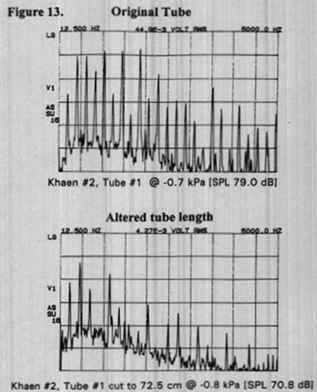
The length of the tubes had a significant affect on the tube spectra. In particular, if the length of the tube does not match the reed frequency very closely the spectrum is greatly affected, even in cases for which the pipe sounds at normal playing pressure. This is illustrated in Figure 13. When the acoustical length of the tube was shortened by 8 cm, the spectrum was significantly affected, especially in the higher harmonics. The overall sound level was lower for the shortened tube, with the sound level being almost 9 dB less.
Conclusions:
The main results can be summarized as follows:
Acknowledgments.
This research project has received major financial support from the Beahl and Irene H. Perrine Faculty Fellowship Program of Coe College. The authors are very much indebted to Professor Terry E. Miller of Kent State University for his helpfulness in all phases of this project, including providing information on the khaen and providing some high quality examples of the instruments for use in our research.
References
1. L.E.R. Picken, C.J. Adkins, and T.F. Page, "The making of a khaen: the free-reed mouth
organ of North-East Thailand," Musica Asiatica, 4, 117-154, Cambridge University
Press, 1984.
2. Terry E. Miller, Traditional music of the Lao: Kaen Playing and Mawlum Singing in
Northeast Thailand, Greenwood Press, Westport, Connecticut, 1985.
3. Terry E. Miller, "Free-Reed Instruments in Asia: A Preliminary Classification," in Music
East and West: Essays in Honor of Walter Kaufmann, Pendragon, New York, 1981.
4. Terry E. Miller, An Introduction to Playing the Kaen, World Music Enterprises, Kent, Ohio,
1991.
5. Robert W. Garfias, "The Asian Free Reed," article with photo and sound examples at the
website: http://www.socsci.uci.edu/rgarfias/asian/freereed.html
6. Kham-Ouane Ratanavong, Apprenez le khene, learn to play the khene, essai d'une methode
moderne, Editions Bulletin des Amis du Royaume Lao, Vientiane, 1973. [in French and
English]
7. Philip D. Koopman and James P. Cottingham, "The acoustics free reeds: a study of reeds
from American reed organs," ROS Bulletin, 15, No. 3-4 (1997)
8. Leonard Mauk, "The Production of Tone in the Reed Organ," ROS Bulletin, February,
1987, 28-32.
9. Robert B. Johnston, "Pitch Control in Harmonica Playing," Acoustics Australia, 15, 69-
75 (1987).
He is currently Associate Professor of Physics at Coe College in Cedar
Rapids, Iowa, where he has been working on musical acoustics research
projects with students since 1991. He is also a regular performer on the
Carpenter, Scott & Wise Western Cottage Organ at the West Branch (Iowa)
Heritage Foundation Museum.
Beginning in 1994, acoustics research at Coe has focused on
the reed organ. Two articles on this research have been
published in the ROS Bulletin, the quarterly journal of the
Reed Organ Society (see references to this article).
Although research on the reed organ is continuing, the study
of free-reed acoustics at Coe expanded in 1997 to include
the khaen, the Laotian free-reed mouth organ. A course on
free reed instruments in being offered at Coe College in
January, 1998.
The authors can be reached at:
Physics Department


Coe College
Cedar Rapids, IA 52402
cafetzer@coe.edu
Invitation to Contributors / Submission
Guidelines Back to The Free-Reed Journal
Contents Page Back to The Classical Free-Reed,
Inc. Home Page